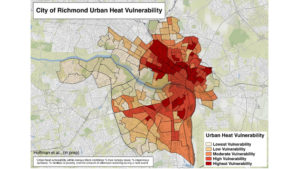
What is it, and what RVA is doing about it.
I checked out an article recently entitled, THROWING SHADE IN RVA — Jeremy S. Hoffman, Ph.D., that was shared to me by a colleague. It looks at the temperature of our city vs. our more rural areas. The data stemmed from another study; Climate | Free Full-Text | Integrating Satellite and Ground Measurements for Predicting Locations of Extreme Urban Heat . The basic rundown is that It’s hotter where there’s less tree canopy and more blacktop and concrete, and cooler where there’s more trees and shade. But why are some areas of our city so abundantly shaded while others are not?
The author looks into the city’s history, particularly back to the 30’s and 40’s when there was “redlining” of districts based on race. It examines why less-affluent areas in the city are especially vulnerable to urban heat intensity, which is increasing with the effects of climate change. Parking lots and buildings warm up more so than shaded and natural areas. This is what’s known as the urban heat island effect.

Of course there is a lot of science behind the study, including ground-based and satellite data – science that I mostly do not understand. But what is very cool is a collaboration between the local organization “Groundwork RVA” and the “Throwing Shade in RVA” Project. This partnership is working in many of those areas where there is a lack of green and natural space. It’s an inspiring endeavor that is engaging teens with their communities to create a better and cooler environment, and so far it’s having good results.
Visit Groundwork RVA here, and
Throwing Shade in RVA here for more info an opportunities to help!


